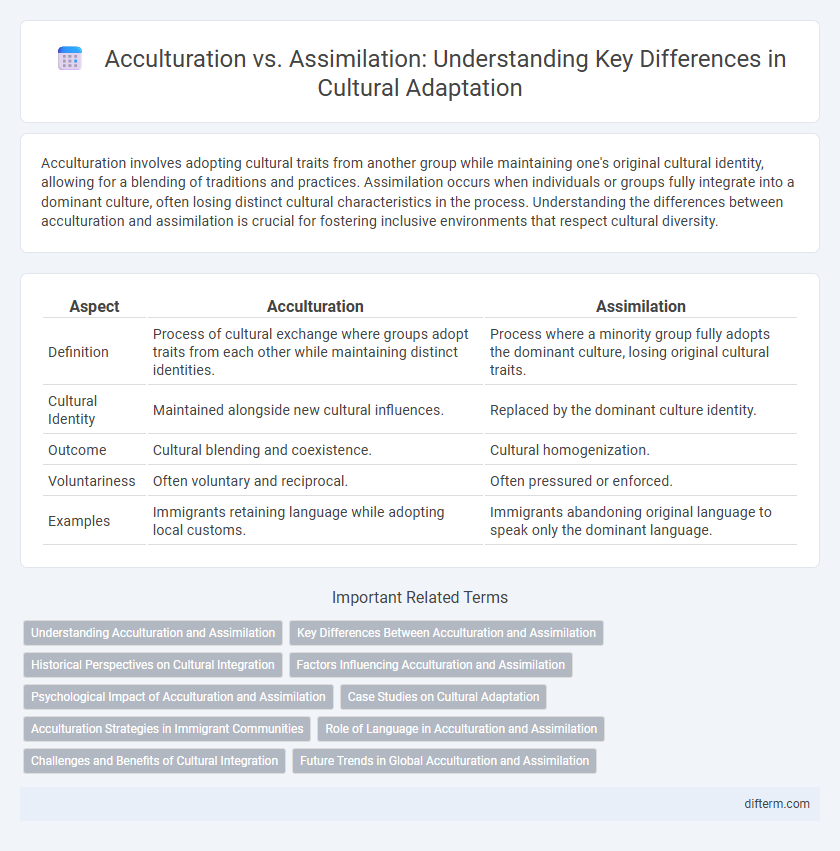Acculturation involves adopting cultural traits from another group while maintaining one's original cultural identity, allowing for a blending of traditions and practices. Assimilation occurs when individuals or groups fully integrate into a dominant culture, often losing distinct cultural characteristics in the process. Understanding the differences between acculturation and assimilation is crucial for fostering inclusive environments that respect cultural diversity.
Table of Comparison
| Aspect | Acculturation | Assimilation |
|---|---|---|
| Definition | Process of cultural exchange where groups adopt traits from each other while maintaining distinct identities. | Process where a minority group fully adopts the dominant culture, losing original cultural traits. |
| Cultural Identity | Maintained alongside new cultural influences. | Replaced by the dominant culture identity. |
| Outcome | Cultural blending and coexistence. | Cultural homogenization. |
| Voluntariness | Often voluntary and reciprocal. | Often pressured or enforced. |
| Examples | Immigrants retaining language while adopting local customs. | Immigrants abandoning original language to speak only the dominant language. |
Understanding Acculturation and Assimilation
Acculturation involves the process through which individuals or groups adopt certain cultural traits or social patterns from another culture while retaining their original identity. Assimilation denotes a more comprehensive absorption where the minority culture gradually loses its distinctiveness to become indistinguishable from the dominant culture. Understanding these dynamics is essential for analyzing cultural adaptation, identity preservation, and social integration within multicultural societies.
Key Differences Between Acculturation and Assimilation
Acculturation involves the process where individuals or groups adopt certain cultural traits while maintaining distinct cultural identities, whereas assimilation requires complete integration into the dominant culture, often leading to loss of original cultural characteristics. Key differences include the retention of heritage in acculturation versus the cultural absorption seen in assimilation. Acculturation promotes multicultural coexistence, while assimilation emphasizes uniformity within the societal framework.
Historical Perspectives on Cultural Integration
Historical perspectives on cultural integration reveal that acculturation allows minority groups to adopt elements of the dominant culture while preserving core aspects of their own identity. Assimilation often demands the complete absorption of minority cultures into the dominant society, leading to the loss of original cultural traits. Studies of immigrant communities in the 19th and 20th centuries illustrate varying outcomes where acculturation promotes multicultural coexistence, whereas assimilation policies have sometimes resulted in cultural erosion.
Factors Influencing Acculturation and Assimilation
Factors influencing acculturation and assimilation include the individual's cultural distance, social networks, and the host society's openness. Language proficiency and socioeconomic status significantly affect the ease and extent of cultural adaptation. Patterns of discrimination and access to institutional support also shape the processes of cultural integration.
Psychological Impact of Acculturation and Assimilation
Acculturation often results in a psychological duality where individuals balance maintaining their original cultural identity while adapting to a new culture, leading to stress but also potential resilience and cognitive flexibility. Assimilation, in contrast, involves a more complete adoption of the host culture, which can cause identity loss, lower self-esteem, and feelings of isolation due to diminished connection with one's cultural roots. Both processes profoundly affect mental health, with acculturation promoting bicultural competence and assimilation potentially increasing risks of cultural alienation and psychological distress.
Case Studies on Cultural Adaptation
Case studies on cultural adaptation reveal distinct patterns between acculturation and assimilation processes. Acculturation often involves individuals or groups adopting specific cultural traits while maintaining core aspects of their original identity, as seen in immigrant communities preserving language and traditions. In contrast, assimilation entails a more comprehensive integration where minority groups gradually lose distinct cultural markers, exemplified by certain indigenous populations adopting dominant societal norms over generations.
Acculturation Strategies in Immigrant Communities
Acculturation strategies in immigrant communities involve four primary approaches: integration, assimilation, separation, and marginalization, each reflecting varying degrees of cultural adaptation and retention. Integration allows immigrants to maintain their original culture while participating in the host society, promoting bicultural competence and social cohesion. These strategies influence identity formation, social inclusion, and mental health outcomes, highlighting the importance of supportive policies and multicultural environments.
Role of Language in Acculturation and Assimilation
Language serves as a critical tool in both acculturation and assimilation processes, acting as a bridge for cultural exchange and integration. In acculturation, bilingualism or maintaining the native language alongside a new language facilitates cultural adaptation while preserving original identity. Assimilation often requires adopting the dominant language exclusively, leading to a deeper immersion and potential loss of the original linguistic heritage.
Challenges and Benefits of Cultural Integration
Acculturation presents challenges such as identity conflicts and language barriers, while offering benefits like increased cultural awareness and social adaptability. Assimilation can lead to loss of cultural heritage, yet it facilitates social cohesion and access to economic opportunities. Effective cultural integration requires balancing preservation of original cultural traits with adaptation to the dominant society.
Future Trends in Global Acculturation and Assimilation
Future trends in global acculturation emphasize the rise of hybrid cultural identities propelled by increased digital connectivity and transnational migration. Assimilation practices may decline in favor of multicultural coexistence, supported by policies promoting cultural pluralism and inclusive social frameworks. Technological advancements will facilitate more dynamic cultural exchanges, challenging traditional assimilation models and fostering diverse cultural syncretism worldwide.
Acculturation vs Assimilation Infographic

 difterm.com
difterm.com